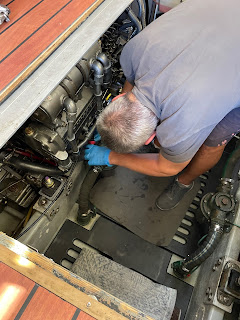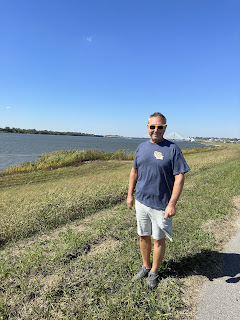St Petersburg to Bradenton...
January 16, 2023
We made good time on our short trip across Tampa Bay passing by the Sushine Skyway Bridge into the Manatee River. We got to see DeSoto point on the Manatee River where Hernando De Soto of Spain came ashore looking for gold. This area is known for boat building as well as being the largest cattle producer in the US at one time. In the late 1800's and early 1900's local ranchers would sale their meat to Cuba. The bountiful seafood both from the Manatee River and the Gulf of Mexico helped to sustain the Indians prior to settlements being established. In the 1800's, there were many Cubans living along the river providing fish to those in the area as well as Cuba.
The day before we left, we took an Uber out to the DeSoto National Monument which is operated by the National Park Service. The area is beautiful on the water and showing reproductions of when DeSoto came ashore. Definitely, a place to stop if you come this way. DeSoto was a Spanish military commander who had found a great deal of gold and silver in Peru and traveled throughout South and Central America. When he returned to Spain, King Charles V gave him permission to go to the Americas to find more gold. Although DeSoto used all his money (gold and silver from Peru) to make the trip happen to the Americas. DeSoto and his men came ashore here in Bradenton. When they came ashore, a man ran up to them speaking Spanish. Juan Ortiz had been with another exploration group and was captured by the Indians. He became the interpreter for DeSoto's group. DeSoto and his men traveled 4000 miles over Florida, Georgia, South Carolina, North Carolina, Mississippi, Tennessee, Alabama, and Arkansas looking for gold without success. In "Mobila" Alabama, DeSoto met with Tuscaloosa, the Indian chief. Tuscaloosa then sent word to Indians further south that the Spanish explorers were coming. DeSoto and his soldiers were ambushed. Many men were killed, captured, and injured. DeSoto refused to give up and continued on the move. Finally when ending up in Arkansas in the cold winter weather, the interpreter, Juan Ortiz dies, DeSoto decides to go back to the Mississippi River to return to Mexico and Cuba. While traveling back, DeSoto developed a fever and died. The explorers buried his body in the Mississippi River so the Indians would not find him.
While walking along the trail at the monument, we saw up close red mangroves and the gumbo limbo tree. Mangroves are essential to aquatic life as they help with gas exchange and provide nurseries for young sea life. There are 3 types of mangroves which are red, white, and black. Red mangroves are the most common ones seen in Florida. The gumbo limbo tree is also known as West Indies birch which is native to Florida. The branches were used to form fences in Cuba and the West Indies. It has a red resin which was used to treat gout. It was stated that pirates would use the limbs from these trees to mark where they buried their treasure. It has acquired the name the "tourist tree" because it stands in the sun, turns red, and then peels. This sounds very familiar! The trees found on the grounds of the park service are believed to be some of the oldest in the state.
Manatee County reached out to the Carnegie Corporation(they financed many libraries) in 1906 to fund their library but were denied. The County made a second attempt and was given the grant to build a library in 1915, opening in 1918. Andrew Carnegie funded 1,946 "Carnegie Libraries" in the US. The Carnegie Libraries typically had a classical style and this one was no different. The library remained here until April, 1978 when a new and larger library was built. The structure was used as a Historical Records Library in 1978 which was the first in Florida and remains so today.
Manatee County reached out to the Carnegie Corporation(they financed many libraries) in 1906 to fund their library but were denied. The County made a second attempt and was given the grant to build a library in 1915, opening in 1918. Andrew Carnegie funded 1,946 "Carnegie Libraries" in the US. The Carnegie Libraries typically had a classical style and this one was no different. The library remained here until April, 1978 when a new and larger library was built. The structure was used as a Historical Records Library in 1978 which was the first in Florida and remains so today.
The Florida Highway Patrol School was started in Bradenton in 1939. The course was 4 weeks in length. The uniform dress at graduation was green shirt and pants with the insignia of an orange on their lapel. The Bradentown Depot was where the Atlantic Coastline Railroad Company operated in Bradenton from 1925-1952 carrying freight north and visitors south. A number of years after the Depot was built, the town dropped the "w" in town to become Bradenton.
The Florida Highway Patrol School was started in Bradenton in 1939. The course was 4 weeks in length. The uniform dress at graduation was green shirt and pants with the insignia of an orange on their lapel. The Bradentown Depot was where the Atlantic Coastline Railroad Company operated in Bradenton from 1925-1952 carrying freight north and visitors south. A number of years after the Depot was built, the town dropped the "w" in town to become Bradenton.
You may have heard the term, "Florida Cracker." There are a number of beers incorporating that name but that's not the answer. Bradenton is the western most point of the Florida Cracker Trail. The trail was the route settlers traveled from the east coast to settle the west coast. Cattle also was moved from the central area of the state to the west coast where the cattle was shipped to Key West and Cuba. This cattle also supplied food to the soldiers in the Confederate Army. Cracker came from the sound the whips made moving the cattle west. The trail started in 1850 and the last major cattle drive was in 1937.
Just so you know, it is not always fun and games on the Great Loop. There was serious work to do which included changing the oil and changing the primary and secondary oil filters on board. Given we have 2 engines, that means this all has to be done in duplicate. You will notice my hand is in the last picture, I did not like the selfie of me holding the oil filter, so it was deleted. This is where I learned that you take oil to businesses which sell it to be recycled. Who knew...
I also was taught how to make a Lazy Daisy Chain by the dock hand at Twin Dolphin.
Got my walking in with and without Danny throughout our week here. Had good dinners out as well as special opportunities. In Sarasota, there is a young woman who own a mobile doughnut truck called Peachey's. It is the best doughnut in the whole world as they do business in Sarasota. They were set up at the hardware store 3 miles away. I walked the 3 miles for the doughnut and Danny went with me. There was a Spanish market according to Apple maps near here but it was incorrect. Danny was looking for Victoria, a Mexican beer, he found in Mississippi. So we ubered to the Spanish market, Danny finds his beer, in addition another beer named Aguila, a Colombian beer he now enjoys not to mention getting Tacos which he said were great. We walked back there today 1.3 miles after going to a Punk Rock Flea Market which was quite interesting and fun to see the items for sale. I did get a shirt. Danny stocked up on more beer, tacos, and fajitas for tonight. Enjoyed a great dinner at a French place, Chateau 13, Obrick's, and Oak & Stone with some friends from Sarasota that live up this way and breakfast at Sage's Biscuit while in Bradenton.

Obrick's had special cocktails that included "Danny Ocean"- Casamigos Tequila, Ruby red grapefruit, and Agave nectar, Lemon which Danny said was quite good.
We enjoyed staying a week in Bradenton and look forward to returning by car or boat!
TOTAL MILES TRAVELLED 1060.2 miles
TOTAL DAYS 66
I also was taught how to make a Lazy Daisy Chain by the dock hand at Twin Dolphin.
Got my walking in with and without Danny throughout our week here. Had good dinners out as well as special opportunities. In Sarasota, there is a young woman who own a mobile doughnut truck called Peachey's. It is the best doughnut in the whole world as they do business in Sarasota. They were set up at the hardware store 3 miles away. I walked the 3 miles for the doughnut and Danny went with me. There was a Spanish market according to Apple maps near here but it was incorrect. Danny was looking for Victoria, a Mexican beer, he found in Mississippi. So we ubered to the Spanish market, Danny finds his beer, in addition another beer named Aguila, a Colombian beer he now enjoys not to mention getting Tacos which he said were great. We walked back there today 1.3 miles after going to a Punk Rock Flea Market which was quite interesting and fun to see the items for sale. I did get a shirt. Danny stocked up on more beer, tacos, and fajitas for tonight. Enjoyed a great dinner at a French place, Chateau 13, Obrick's, and Oak & Stone with some friends from Sarasota that live up this way and breakfast at Sage's Biscuit while in Bradenton.

Obrick's had special cocktails that included "Danny Ocean"- Casamigos Tequila, Ruby red grapefruit, and Agave nectar, Lemon which Danny said was quite good.
We enjoyed staying a week in Bradenton and look forward to returning by car or boat!
TOTAL MILES TRAVELLED 1060.2 miles
TOTAL DAYS 66



















Comments
Post a Comment